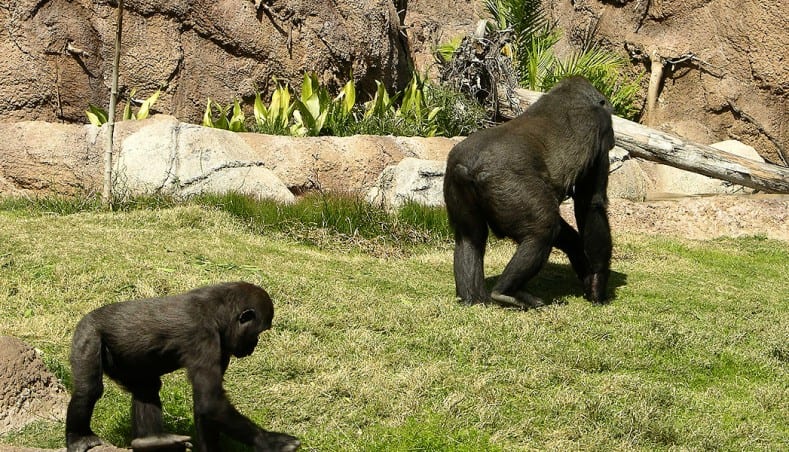How to Build Natural Habitats for Animals at Zoological Parks
Posted in News -

It takes talent, but also a knowledge of the animals’ foraging habits, physical capabilities and natural surroundings.
You may never have the opportunity to watch gorillas on an African safari, photograph a kangaroo in Australia or view a polar bear in the Arctic. But that doesn’t mean you have to travel far to immerse yourself in any of these experiences. You can thank the talented construction teams that recreate those natural habitats closer to home for that.
It takes talent, imagination and a deep understanding of each animal and its environment to create effective zoological and aquarium exhibits. The exhibit must not only help ensure the animals thrive, but that it educates its biggest fan – humans.
Zoos and aquariums make major investments to recreate exhibits that mirror the natural habitat of each animal, whether the animal resides at a zoological park or aquarium. These wildlife exhibits feature climate control, waterfalls, lakes and rockwork that help them live a healthy and fulfilling life.
While water features and rockwork help support land-dwelling animals, aquatic life in aquariums relies on a complex Life Support System (LSS) that controls and monitors their underwater environment.
Zoos and aquariums strive to recreate an animal’s natural habitat, but they must also protect what they’re built to attract – us. Each containment facility must be designed to engage visitors, so they can better understand wildlife and the challenges of preservation and conservation while ensuring the safety of the visitors and the animals.
Builders of zoos and aquariums merge safety and aesthetics when creating exhibits. They create towering boulders, mud banks and water features that not only mimic the animal’s habitat, but serve as natural boundaries between wildlife and humans.
Some of the most well-known exhibits that combine the beauty of nature with the safety of wildlife and humans include:
Reserve, Los Angeles Zoo & Botanical Gardens
Los Angeles California
At the Campo Gorilla Preserve, craftsmen constructed a massive monolith and mud bank that keeps the lowland gorillas contained. At the same time, visitors are protected as they view the gorillas at a safe distance, but close enough to view the gorilla’s behavior.
The exhibit’s designers developed a full understanding of the gorillas’ habitat in the wild, sense of territoriality, foraging habits and physical capabilities while tackling this project. Then, they took these factors into account while building the habitat to ensure the survival of this critically endangered animal.
National Aviary Penguin Point Exhibit
Pittsburgh, Pennsylvania
African Penguins swim among artificial rocks in an unbelievably believable habitat the Outside the Lines team helped create at the National Aviary zoological park exhibit. The team worked with architects and the aviary curator to establish a 2,300-square-foot exhibit that replicates the penguin’s natural habitat.
Voyage to Australia and the Islands, Columbus Zoo
Columbus, Ohio

Artisans re-created the wild wonders of Australia at this zoological park. The zoo exhibit explores the exotic wildlife and plants in Australia, New Zealand, Southeast Asia and Indonesia.
Artisans completed themed building facades and a variety of rockwork features, such as hand-sculpted artificial trees and vines, a replica of the Ayers Rock sandstone formation in Australia and iconic art pieces.
The Maryland Zoo Polar Bear Watch
Baltimore, Maryland

It may be thousands of miles from the Arctic, but the Polar Bear exhibit at the Maryland Zoo looks and feels like home to the polar bear. The exhibit features pools of water and artificial stylized rockscapes indigenous to the bear’s natural environment.
The exhibit mirrors the coastal areas where polar bears forage for food. Working with the zoo’s design team, craftsmen incorporated a genuine Tundra Buggy into the exhibit. The Tundra Buggy is a 57-foot long, 12-foot high, 25-ton vehicle that serves as a comfortable observation area and the site of the unique Adventure Learning Center. The buggy is an out-of-service all-terrain vehicle once used as a viewing platform for photographing and watching polar bears and Arctic wildlife.
Georgia Aquarium
Atlanta, Georgia

Craftsmen helped bring the wonder of the world’s sea creatures to the Georgia Aquarium, which features more animals than any other aquarium in the world. Craftsmen created an environment that helps preserve the earth’s aquatic biodiversity in nearly 10 million gallons of water. Trout, piranhas, octopuses and other species thrive in its cold and fresh water exhibits. The exhibits feature artificial reefs, rockwork, trees and roots, all features indigenous to their natural habitat.
The Georgia Aquarium features a technologically advanced pump and filtration system. The Life Support System contains more than 10 million gallons of water in over 60 habitats. The aquarium’s life support equipment is highly automated and controlled by a state-of-the-art system that can make 150 million decisions per second through a network of 24 computers.
Outside the Lines’ ability to recreate natural habitats that thrill both humans and zoo and aquarium wildlife has made the company a valuable and trusted member of construction teams at a multitude of zoological parks and aquariums. If you would like to tap their expertise, please contact OTL at: (714) 637-4747 or email them at info@otl-inc.com
Featured Articles
- From Cancer to Racecar Driver: The Amazing Story of Gabe Tesch
- OTL’s Sarah Shores to Speak on Women in Construction Panel
- Innovative Patented AI Technology Takes Retail Experience to New Heights at 85-Acre Retail Property in Riverton, UT
- AI Drives Show-Fountain Experiences
- My Favorite Project: The Towers at Williams Square

